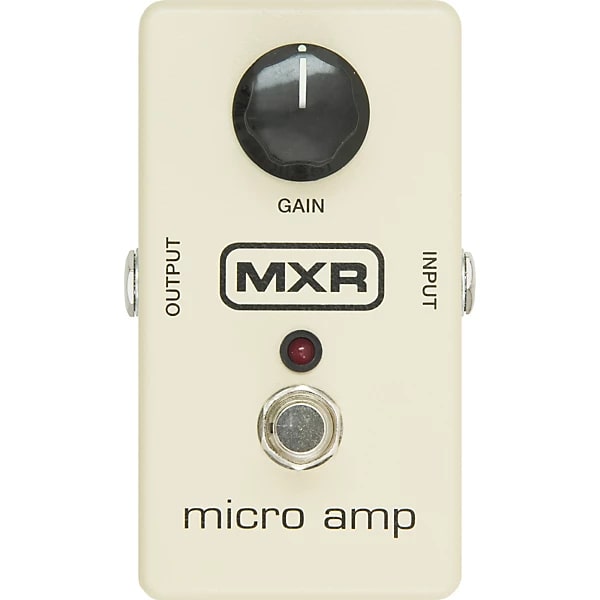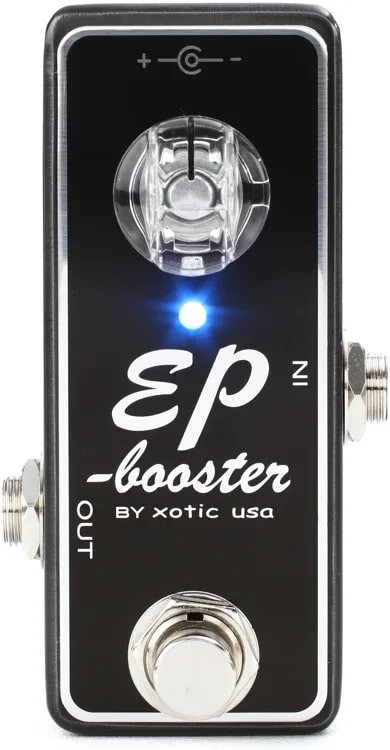When you buy through our links, we may earn an affiliate commission.
You're onstage in the middle of a performance. You're playing your best song and really feeling the energy swell.
The pre-chorus kicks in, and you get ready to shift gears. Now the chorus... stomp that overdrive pedal. The fans are hanging on to every word and loving it. You've got them in the palm of your hand.
Really wrench everything you've got out of that last line—it's solo time—and... your solo falls flat. No one can even hear you giving it all you've got because you've already maxed out your dynamics, and your overdriven tone just isn't enough to make your leads cut through.
This is where your new secret weapon comes in: the boost pedal.
For that extra smidge of power to take your sound to the next level without making significant changes to your tone, there's nothing like a good boost pedal.
And we've rounded up the best boost pedals available, so you don't have to sort through all the options out there.
Our pick for the best overall boost pedal is the MXR Micro Amp. This is a straightforward boost that's easy to use and perfect for, well, boosting your tone without coloring it.
But that doesn't even scratch the surface—we've got clean boosts, drive boosts, EQ boosts, and more on this list.
Read on to find out which boost pedal is the right one for you. Trust us, you need one.
Quick Summary of the Best Boost Pedals
- MXR M133 Micro Amp Gain / Boost Pedal (Best Boost Pedal Overall)
- Electro-Harmonix LPB-1 Nano Linear Power Booster (Best Budget Boost Pedal)
- TC Electronic Spark Mini Booster (Best Clean Boost)
- Xotic EP Booster Mini (Best Preamp Boost)
- Walrus Audio Emissary Parallel Boost Pedal (Best Boost/EQ)
- MXR Timmy (Best Drive/Boost)
- Keeley Katana (Best Boost Pedal for Versatility)
Best Boost Pedals
1. Best Overall – MXR M133 Micro Amp Gain / Boost Pedal

SPECS
- Type: Analog Gain Boost
- Bypass: Hardwire
- Power Requirements: 9V DC power supply required
For an easy-to-use, simple boost pedal that's going to boost your signal while preserving your guitar tone, look no further than the MXR Micro Amp. This pedal does one job and does it well—delivering an excellent boost range in a simple, durable, affordable package.
The MXR Micro Amp is one of the most popular boost pedals for a good reason: its +26db boost gives you plenty of power with virtually no tone coloration. Its single rotating control knob is as simple as it gets, so you can just dial it in and stomp away.
You want your boost pedal to be no-frills (that's kind of the point). If you're looking for a straight-ahead booster to push your tube amp right into the sweet spot without messing with your EQs, go for the MXR Micro Amp.
2. Best Budget Boost Pedal – Electro-Harmonix LPB-1 Nano Linear Power Booster

SPECS
- Type: Gain Boost
- Bypass: True bypass
- Power Requirements: 9V DC power supply required
If you want a boost that adds a bit more character to your tone, the Electo-Harmonix LPB-1 is a great choice. It's an exact re-creation of the original LPB-1 circuit, which is sometimes credited with bringing on the age of overdrive in 1968.
The LPB-1 is a great extra gain stage to overdrive an amplifier. It boasts a really dynamic response that makes it ideal for live settings. Featuring a single gain knob and built with EHX's apocalypse-proof die-cast housing, this is a tough and useful little boost.
For a vintage-style linear power boost, you can't beat the original. Add to all this the fact that it is one of the most affordable boost pedals on the market, and we think it makes a pretty compelling contender for one of the best boost pedals available.
3. Best Clean Boost – TC Electronic Spark Mini Booster

SPECS
- Type: Analog Level Boost
- Bypass: True bypass
- Power Requirements: 9V DC power supply (sold separately)
You're shopping for a boost, not an overdrive pedal. So why not go all in on a clean boost? For a clean boost pedal that's simply going to give you that extra kick of volume you need, you can't do much better than the TC Electronic Spark Mini Booster.
With its discrete analog circuitry and true bypass design, you're ensured of preserving your tone. Speaking of switching—this pedal features a "Prime Time" mode, which allows you to hold the switch down for quick sections rather than fumbling to switch it on and off.
You'll get a ton of value out of this pedal—it's great "always on" and is priced super affordably. For a great transparent boost that offers a 20+db clean boost, a touch of compression, and a whole lot of style to your pedalboard, the TC Spark Mini is a sure bet.
4. Best Preamp Boost – Xotic EP Booster Mini

SPECS
- Type: Preamp Boost
- Bypass: True bypass
- Power Requirements: 9v DC Power Supply
Legend has it that, in the days of the Echoplex tape delay, players liked the sound of its preamp so much that they would keep the device in their signal chain long after the delay function had given out.
Fast forward to today. Xotic brings us the EP Booster, an amazing preamp boost based on the vaunted preamp stage of the EP-3. This pedal not only gives incredible tone coloration but a ton of versatility as well, thanks to its internal boost frequency and EQ controls.
It also features a true bypass design, so you can switch it off and bypass all that incredible tone should you choose to. If you're looking for a pedal that simply blows other preamp boost pedals out of the water, you've found it in the Xotic EP Booster.
5. Best Boost/EQ – Walrus Audio Emissary Parallel Boost Pedal

SPECS
- Type: Analog Parallel Boost
- Bypass: True Bypass
- Power Requirements: 9V DC power supply (sold separately)
Walrus Audio brings us a unique EQ boost with the Emissary Parallel Boost. This versatile pedal features two independent boost circuits wired in parallel that you can use independently or mix a combination of the two for endlessly customizable tone options.
The Bright knob controls a super clean, bright JFET treble booster, while the Mid controls your midrange. You can dial in your midrange tone even further using the frequency selector toggle switch. Mix the bright and mid-circuit to your heart's content for everything from lively jangle to punchy mids.
While certainly among the pricier boosts on this list, this pedal earns its price tag by offering a lot more options and features than your average boost. For a boosted tone that's uniquely customizable and versatile, there's no parallel to the Emissary.
6. Best Drive/Boost – MXR Timmy

SPECS
- Type: Analog Overdrive
- Bypass: MXR True Hardwire Bypass
- Power Requirements: 9V DC power supply (sold separately)
While the Timmy is technically a transparent overdrive, we had to include it because it is also one of the best boost pedals money can buy. It offers more tonal options than other boost pedals on this list, such as a switchable clipping selector, but we'll focus here on the boost.
The Timmy features cut-only EQs, which allow you to dial in your bass and treble levels without overhyping your signal and spoiling your tone. As a boost, the Timmy tightens and focuses your tone without significantly altering your core guitar signal.
There's a lot more where that came from to recommend the Timmy (see our list of the best overdrive pedals for more). If you're looking for a versatile pedal that can give you a nice, transparent clean boost as well as an array of overdrive options, the Timmy is a great way to go.
7. Best Boost Pedal for Versatility – Keeley Katana

SPECS
- Type: Analog Boost
- Bypass: True bypass
- Power Requirements: 9V DC power supply (sold separately)
The Keeley Katana shines as one of the best clean boost pedals available. Boasting great versatility, unique functionality, and all-around amazing sound, the Katana is well worth its steeper price if you're looking for a boost pedal that does it all and more.
Keeley really thought outside the box on this design. The gain knob is mounted on the side so you can control it with your foot during performances. Plus, you can pull the knob out for an extra gain stage, unleashing an array of saturated higher-gain tones.
The Katana also features an internal voltage doubler for extra headroom and response, a really cool option not found on most boost pedals.
This is an ideal boost pedal for players looking for a clean boost with a high gain mode. It's definitely at the higher end of the price spectrum, but it's well worth it for players looking to get every nuance out of their guitar rig.
Best Boost Pedals Buyer's Guide
We know shopping for a boost pedal can be tricky. There are tons of options out there, and as the nature of the pedal is subtle, to begin with, it can be really hard to parse what exactly you are looking for.
If the above list didn't make things clear enough for you, and you're still having trouble making a choice, not to worry. Our buyer's guide is here to help you sort through the nitty-gritty details of these awesome pedals and figure out just what you need.
And in case you want to know more, we've included an FAQ section that might answer some of your burning questions related to our topic.
Read on to learn everything you've ever wanted to know about boost pedals!
Type of Boost
Boost pedals generally come in a few different varieties. These can include clean boosts, preamp boosts, EQ boosts, and more.
A clean boost like the MXR M133 Micro Amp is pretty much what you might imagine: it's going to provide a volume increase without altering the tone significantly, giving you a nice pick-me-up for your core tone while preserving its character.
Preamp boosts, like the Xotic EP Booster Mini, can add a certain character or tonal flavor. They're great for an "always on" pedal or as a means of boosting your signal while also giving its character a little extra seasoning.
If you want your boost to come with a bit more control, an EQ boost like the Walrus Audio Emissary Parallel Boost might be a good option for you. This will allow you to smooth out your tone for a little more or less top-end or midrange on your boosted tone.
Tone
When assessing the tonal qualities of a booster pedal, the main things you're going to want to examine are its level of transparency and its gain range.
Many clean boosts aim to maintain the original tone of your guitar and amplifier. This preservation of your core tone is what's known as "transparency." If you're attached to your tone and just want a signal boost, a clean boost is probably your best bet.
As mentioned above, some boosts may introduce coloration or saturation to your sound. Decide whether you prefer a transparent boost or if you're open to some tonal enhancements.
Finally, different pedals feature a different gain range. Gain range refers to the amount of boost you're going to get from the pedal. Some pedals offer a subtle volume increase, while others provide a significant gain boost for driving tube amps or adding saturation.
Controls
Boost pedals feature a variety of switching options. Most pedals have at least a simple on/off switch, but some offer additional features like internal dip switches and toggle switches for different boost levels.
They're generally all going to have a gain knob, but there can be some differences here as well. For example, the Keeley Katana features a gain knob that's mounted on the side so you can roll it with your foot during a performance.
Do you feel like you need EQ controls on your boost pedal? Some boost pedals offer additional tone-shaping options such as treble, mid, and bass controls. These can be useful for tailoring your boosted sound to match your guitar, amplifier, or personal tonal preferences.
Build Quality and Size
Your boost pedal is going to get some serious use—and anything that you literally stomp on night after night is going to have to be tough. Look for durable construction that can withstand regular use (and abuse). You can't go wrong with the die cast housing on the Electro-Harmonix LPB-1.
It's also not a bad idea to ensure the size of the pedal fits your pedalboard. Compact pedals are more pedalboard-friendly, while larger pedals may provide more controls and features. There are tons of great mini pedals, like the MXR M133 Micro Amp, if you want something smaller.
Frequently Asked Questions (FAQs)
What is a boost pedal, and what does it do?
A boost pedal is an effects pedal that increases the volume or gain of the guitar signal. It can be used to boost the volume during solos, push a tube amp into overdrive, or enhance the overall signal strength.
A transparent boost pedal should have minimal impact on your tone, especially when used conservatively. However, some boost pedals may introduce slight coloration or tonal enhancements, particularly those with EQ controls or specific tonal characteristics.
A clean boost is designed to increase the volume without significantly altering the tone of your guitar and amplifier. It aims to maintain transparency and clarity and preserve your guitar and amp's natural characteristics.
On the other hand, a colored boost intentionally adds certain tonal characteristics or coloration to the signal, enhancing the overall tone in a specific way.
As outlined above in the buyer's guide, there are a number of different features. But the pedal's main job is always going to be boosting your signal.
What is the difference between a boost pedal and an overdrive/distortion pedal?
While both boost pedals and overdrive/distortion pedals can increase the gain of the signal, the main difference lies in their intended purpose. In fact, we've even included an overdrive pedal on this list due to its great functionality as a boost.
The point of a boost pedal is to increase volume without significant tonal alteration, while overdrive/distortion pedals generate additional saturation and clipping to create a distorted tone.
Boost pedals do provide some gain to varying degrees. If you're looking for a clean volume boost, a pedal with +20db or so will suffice. However, if you want to drive a tube amplifier or add saturation, you may need a boost pedal with a higher gain range.
Or just get a clean boost AND an overdrive pedal!
We'd also like to point out that a boost is not going to be able to replace an amplifier's built-in gain or overdrive channel. While a boost pedal can push the front end of an amp and provide some gain, it cannot replicate the complexity and dynamics of an amp's natural overdrive.
Can a boost pedal be used with other effects pedals?
Yes, boost pedals can be used in conjunction with other effects pedals. They are often placed at the beginning of the signal chain to increase the overall volume going into subsequent pedals and the amplifier.
This can help push other pedals into higher levels of saturation or provide a consistent level of boost throughout the signal chain.
A boost pedal can also be used as a standalone effect. Even without other pedals or an overdriven amplifier, a boost pedal can provide a volume boost for solos or increase the signal strength of your guitar.
Verdict
Hopefully, by now, you have concluded that A) you absolutely need a boost pedal in your electric guitar rig and B) you are going to buy one of the awesome pedals reviewed above from Sweetwater.
If this is not the case, do yourself a favor and take another look at our picks for the best boost pedals. You're sure to find the boost pedal that's right for you and your needs.
Our top pick for the best overall boost pedal was the MXR Micro Amp. We think it's as close as you can get to the living embodiment of what a boost pedal should be.
But if you're looking for something with more pizzaz, there are some great options for preamp boosts, EQ boosts, and more.
Thanks for checking out our list, and we hope you enjoy your new boost pedal!
